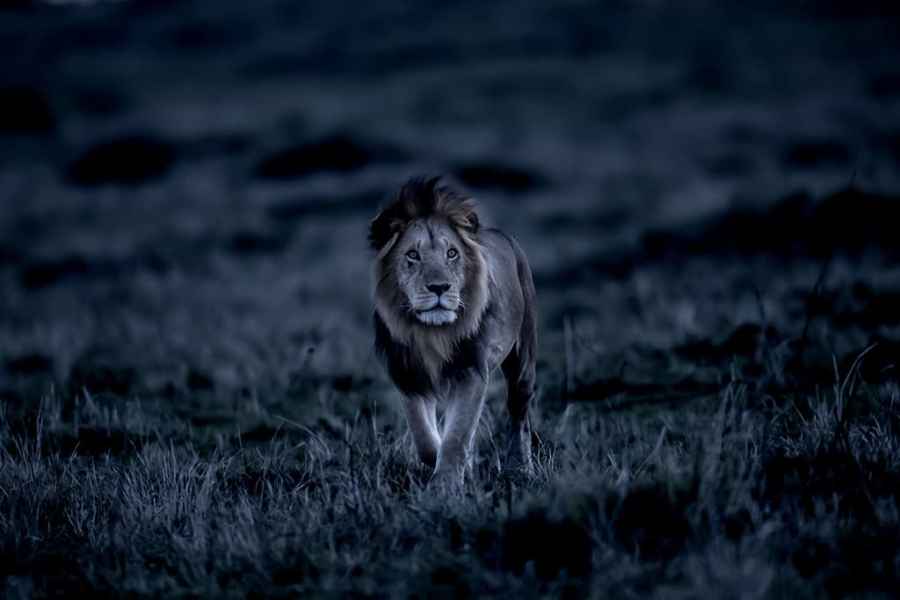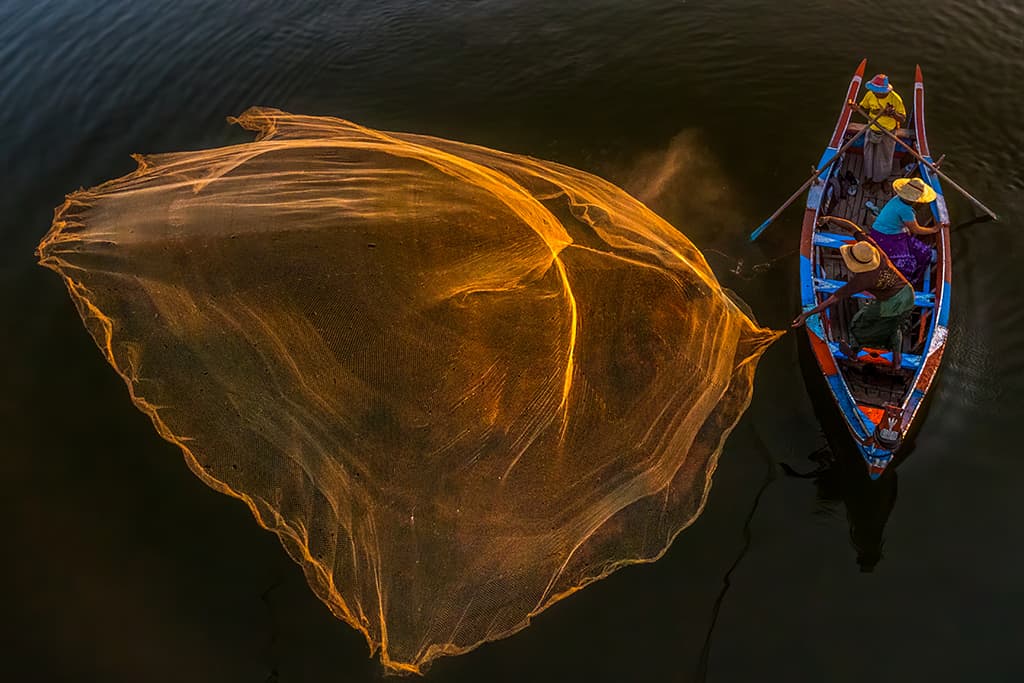Art Wolfe has been photographing after dark for decades. He exclusively reveals to David Clark what attracts him to the nocturnal world and why is he enjoying shooting it more than ever, plus tips on how to improve your night photography.
‘I’m battling raccoons right now,’ says Art Wolfe over a Zoom call from his home in Seattle, USA. ‘I’ve got koi carp in a pond in my garden and the raccoons come up out of the ravine below my house to get them. I was up until about 1am last night, chasing raccoons away. They’re a pain in the ass. They’re cute, but they love to eat fish. I’m at war with nature,’ he laughs.
It’s not the expected start to an interview with one of the world’s most famous nature photographers. Art may have just passed his 70th birthday, but he’s as energetic, unpredictable and candid as ever. Art has been photographing wildlife, landscapes and people for over 45 years and during a highly successful career has shot over two million images.
He has maintained a packed travel schedule throughout his working life, barely arriving home from one far-flung trip before setting off on another. Before coronavirus arrived, he regularly travelled for more than nine months every year.
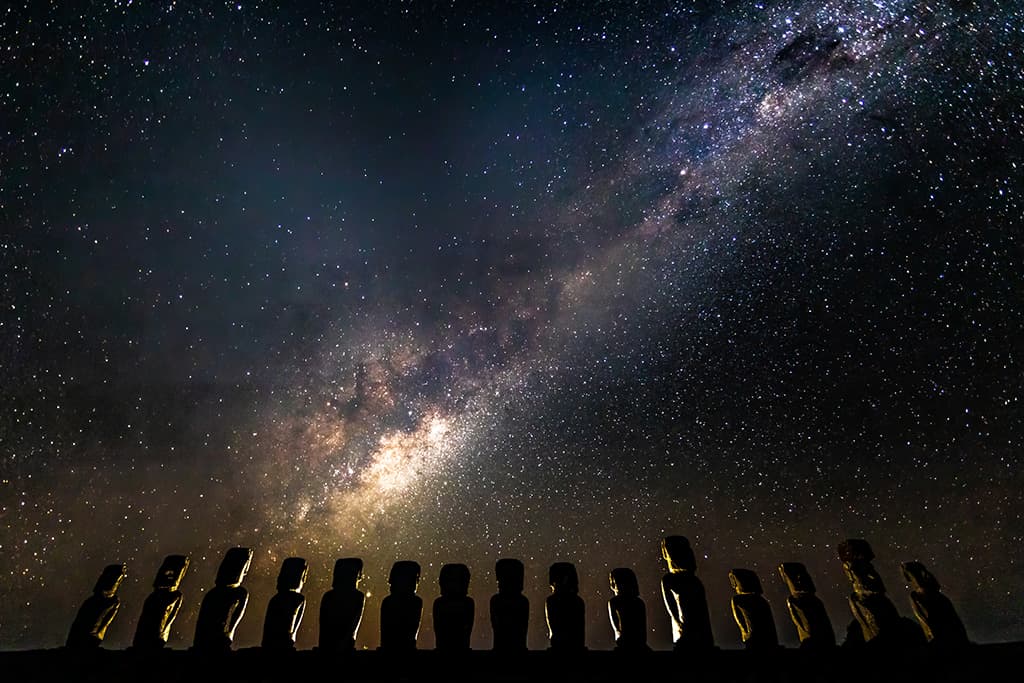
A dramatic shot of the Milky Way over a row of moai on Easter Island (Rapa Nui), in the south-eastern Pacific Ocean
Even the Covid-19 situation hasn’t stemmed the flow of restless energy that drives him. ‘The pandemic has not slowed me down,’ he says. ‘All last year I created 27 lectures (each lecture 90-minutes long) on Pathways to Creativity that we put on Vimeo.
As long as my life is busy and my brain is active, I’m a happy camper whether I’m in Africa or North America. I’m still finding great things to do and great new subjects to shoot.’
Earlier this year Art went on safari to Kenya and for the past two months has taught back-to-back workshops in North America. He’s just come back from snorkelling with whale sharks and giant manta rays off the coast of Mexico.
He’s currently trying to run tours to Africa, Mongolia and Madagascar, but keeps having to delay them because of the pandemic’s travel restrictions, although he’s fully vaccinated and requires the same from his participants.
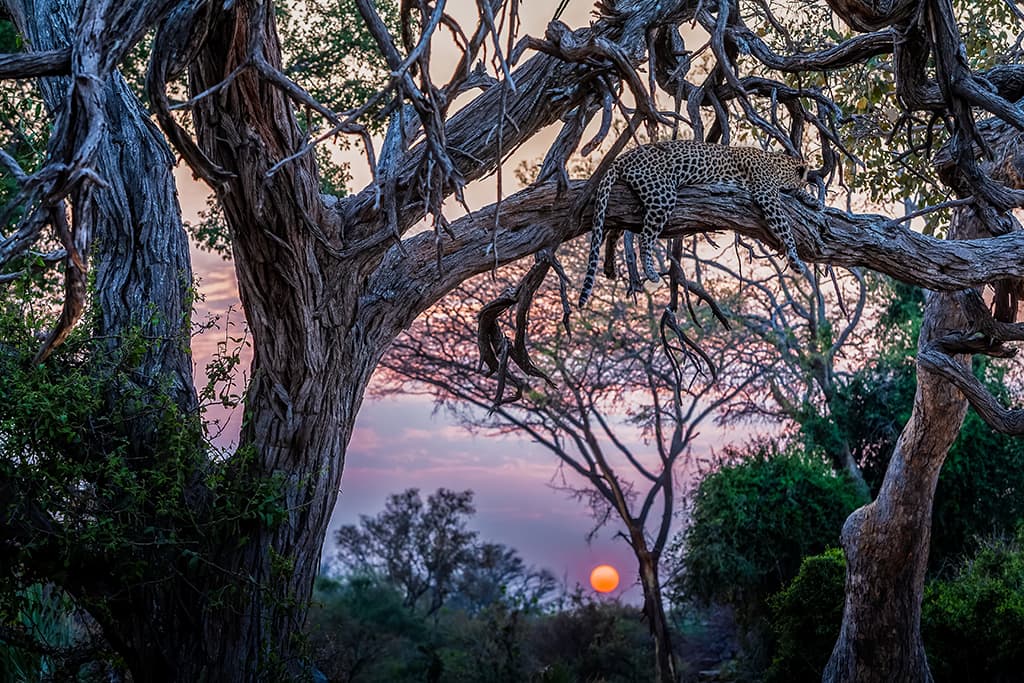
This shot of a leopard in an ancient thorn tree in Chobe National Park, Botswana, Africa is one of Art’s favourites in Night on Earth. ‘I love shots where the animal is just part of the overall landscape,’ he says
Art’s keen to resume these tours. ‘My entire life has been about managing risk,’ he continues. ‘I started off as a kid that was always rummaging around in the forest and jumping off trees and crossing rivers. I was formally trained in mountaineering, went on an Everest expedition, went up to K2 and went into Pakistan even after the first Gulf War.
‘I always have been empowered to travel the world, to go into any city on Earth and walk the back streets and not feel like a victim or fearful of other humans. My parents always taught me to be self-reliant and confident, and that was the best thing they ever instilled in me.’
Over the years, Art has maintained a steady flow of books and has so far produced more than 120, including Migrations: Wildlife in Motion (1994), Vanishing Act (2006), which explored camouflage in nature, and his epic ‘mid-career retrospective’ Earth is My Witness (2014). He currently has seven more books at different stages of completion.
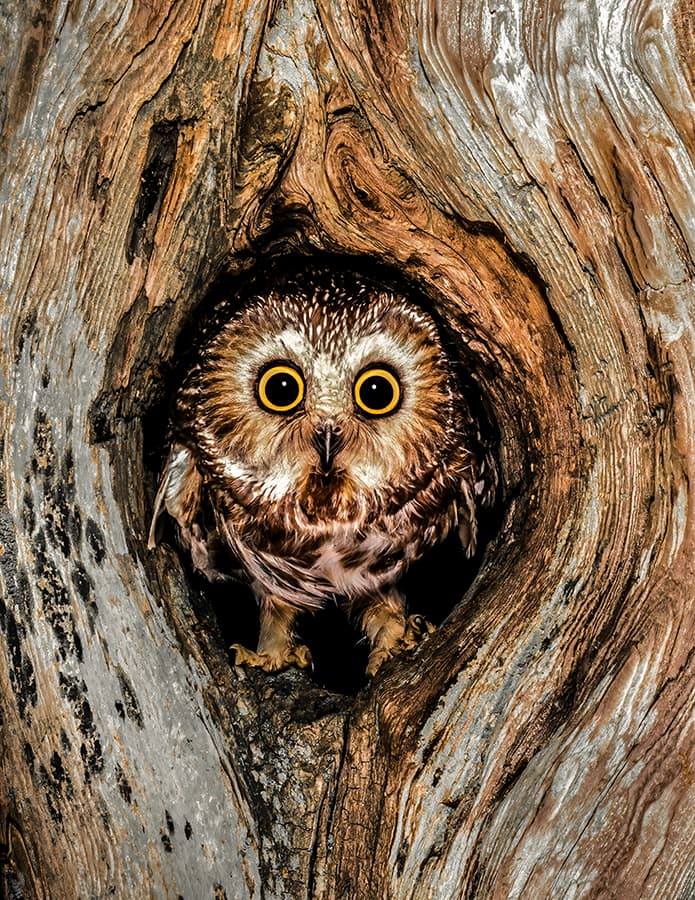
This northern saw-whet owl was photographed while preparing to leave its nesting cavity in a tree in Washington, USA
Night on Earth
His latest book, Night on Earth, is a wide-ranging collection of travel images made in the hours between dusk and dawn. Taken in a variety of locations worldwide including Alaska, Namibia, Malaysia, India and the Galapagos Islands, it features landscapes, starscapes, wildlife, natural phenomena such as volcanoes and waterfalls, indigenous peoples, cities and more.
So why has Art chosen to focus on night photography for this book? What is it that intrigues him about it and what special photographic opportunities does it offer? ‘Whenever I shoot, first and foremost, I’m trying to affect the emotions of the audience,’ Art explains.
‘In the past, when giving a talk, I could wow my audience with amazing shots of things like the Patagonian Massifs, but today people start to yawn because they’ve already seen 10,000 of those images. It’s getting harder to wow anybody with a more traditional landscape. So, part of the motivation was to include the element of darkness and to capture the landscape in a slightly different way.’

Shooting between dusk and dawn gives images a unique atmosphere. Here, an African lion is shown in the muted light of evening in Masai Mara National Reserve in Kenya
Part of the attraction for Art was the sense of mystery that the night brings. ‘If you can capture, for instance, a mountain lion at dusk, starting to stalk an animal, that already implies some people’s worst fears,’ he says. ‘It’s already affecting people’s emotions. The subject has this inherent interest already ingrained.
I love that sense of going into the dark and coming away with an image that isn’t just silhouetted darkness. That, for me, was the challenge.’ For most of his books, Art usually goes through the same process when compiling them. After initially coming up with the concept, he and his staff search through his vast archive to see if there are enough core images to draw from.
All the travel that’s involved in covering a wide range of subjects and locations means it’s not financially viable to shoot all new images for books. ‘Then, once a base is established, I work like hell for the next three or four years and usually end up replacing most of the images that we initially thought would be good,’ he reveals.
‘I don’t want a book to come out that looks like a lot of old photos. For the most part I’m shooting new work and using the abilities of the latest cameras to take in what we could never have shot before.’
Although a small number of the images in the book were shot on film SLR cameras and have stood the test of time, many of them were taken on the latest digital kit including the Canon EOS R5, which is currently his main camera. ‘I love it,’ he enthuses. ‘The whole technology of the mirrorless camera permits much smaller lenses.
‘For instance, when I was in Kenya earlier this year, I was handholding an RF 100-500mm f/4.5-7.1 lens and very easily capturing animals. Then I could add a 1.4x extender and suddenly I have a 700mm lens that’s very easy to hold. I’m not a gym queen, so handholding and shooting animals without a tripod really makes capturing the ephemeral moment so much easier.’
One way he has taken advantage of the greatly improved high ISO performance of today’s cameras has been to shoot starscapes in a way that was not previously possible. ‘Historically, if I’d wanted to shoot a night-time shot that includes the stars, they would all be star trails,’ confirms Art.
‘With film, you could never take a fast enough shutter speed to show the stars were just pinpoints of light. Those star trail images can be spectacular but can get a little shallow in terms of the depth of the image. ‘Today, with high ISOs, I have been able to shoot amazingly detailed images of the Milky Way as part of night-time landscapes.
Higher-ISO cameras are enabling us to photograph landscapes and the heavens like never before. I think that’s a great advancement and I only see it getting more and more that way.’ Almost all Art’s dusk-to-dawn images have been shot using only ambient light, including those of traditional ceremonies in countries including India, Botswana and Ethiopia.
He prefers to increase his ISO and use traditional oil lamps, candle light and fire light to illuminate these scenes. ‘The ones I’m really proud of are the cultural shots lit with candle light or fire light. They’re so much more intimate and romantic, and in keeping with nature and the landscape, than they would be if shot using flash. Most of the time in these situations flash is too harsh and invasive.’
Light pollution
Part of Night on Earth’s purpose, as is made clear in the text, is to highlight the issue of light pollution and how it’s affecting both wildlife and people as well as wasting resources.
As Ruskin Hartley of the International Dark-Sky Association writes in the foreword, ‘Light pollution is destroying natural darkness with severe consequences: It is linked to a global insect decline, the death of millions of migrating birds, increased carbon emissions and increased disease in humans.’

A lava flow glows vividly in this night-time shot of an eruption of Bárðarbunga, a subglacial stratovolcano in Vatnajökull National Park, Iceland
The last photographs Art made for the book show the spectacular, star-filled night sky at the Natural Bridges National Monument in Utah, USA, which, in 2007, became the first of the country’s International Dark Sky Parks, which are specifically protected from light pollution.
At a time of climate emergency, Art says he’s often asked why his photographs focus on the beauty of nature and don’t show degraded environments, decimated species, or evidence of pollution. ‘The answer is I want to make a beautiful book to lure people in to where the organisations with which we align can tell their story,’ he explains.
‘It’s my honour to produce books in a way that brings people in and then we deliver the message, as opposed to books that show nothing but carnage. Very few people really are going to buy books on something that’s depressing, because we have enough issues that stress people out already.’
As for his future work, there’s no chance that entering his eighth decade is going to slow Art down. ‘My friends recently brought up the fact that I’m turning 70,’ he says. ‘We’re all within a year of each other. People say, “Oh my god, it’s a big birthday, it really makes you think”. But I live in denial and I’m not going to give it a thought. Birthdays are almost irrelevant to me.
‘My belief is, don’t look in the mirror, just look outward, think about the next project. Life is moving fast for all of us, but I don’t want to start thinking about how much time I have left and all that. People ask me when I’m going to slow down and retire, but artists don’t retire. I just want to drop wherever I am.’
Art Wolfe’s low-light tips
Based on his experience, Art shares the advice he would give others for shooting in low light
1. Think out of the box
‘Most people, whether taking low-light shots or otherwise, are literally putting their tripods in the holes made by the previous person to shoot that place. Look for new ways and new angles to approach the subject.’
2. Invest in the latest equipment
‘If it’s within your price range, the high ISO capability of the latest camera bodies, such as the Canon EOS R5, makes a big difference when shooting in low light, allowing you to capture subjects that were not previously possible.’
3. Understand animal behaviour
‘When photographing wildlife on the margins at dusk, it’s essential that you familiarise yourself with the behaviour of the subject that you want to go after. For example, you locate some predators by listening to the calls of their prey.’
4. Don’t be afraid to include motion blur
‘As long as there’s an element in the frame that’s sharp for the eye to depart from, shots that include motion blur can often be the most effective and creative.’
5. Noise isn’t a big issue
‘For me, a little noise in low-light shots is not a bad thing, so long as you’ve got the image. Noise can be akin to grain, which often creates something artistic.’
6. But for noise-free images…
‘If I’m trying to get the clearest, sharpest image without noise, I will use the latest cameras and typically will shoot starscapes, for example, somewhere around ISO 1600 with an aperture of f/1.4 or sometimes f/2.8 for around 10-20 seconds. Then I use Topaz noise-reduction software in post.’
Night on Earth: Photographs by Art Wolfe is published by Earth Aware Editions, price £35. See www.artwolfe.com. Amateur Photographer readers can also enjoy a 25% discount off ‘Pathways to Creativity’. See events.artwolfe.com/pathways and use the code AP25.
Further reading
- Night landscape photography
- Nature and nurture: Art Wolfe on his approach to photography
- Art Wolfe 1951-present – Iconic Photographer
- Night photography: how to photograph the night sky, moon and stars

